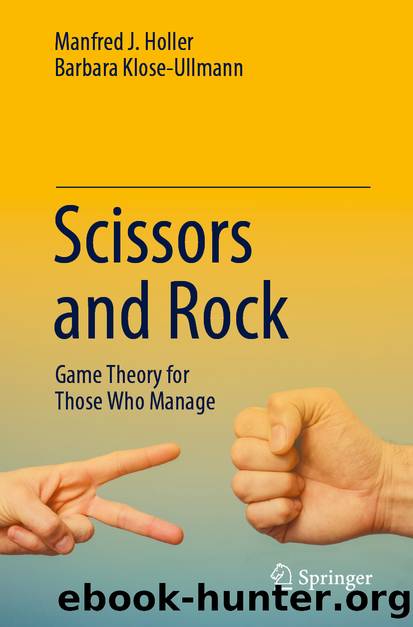Scissors and Rock by Manfred J. Holler & Barbara Klose-Ullmann

Author:Manfred J. Holler & Barbara Klose-Ullmann
Language: eng
Format: epub
ISBN: 9783030448233
Publisher: Springer International Publishing
Starting at position X, the end game has the structure depicted in Fig. 8.2. Player 1 compares the payoffs of player 2, resulting from choosing T and NT in A and B, respectively. He concludes that player 2 will choose the move NT when in A, and move T when in B. Consequently, it will be better for him, being the first player to move, to choose B instead of A. The resulting payoff pair (1, 2) will give him the second worst of the four possible results but if he opts for A he gets the lowest payoff possible for him, namely 0.
This type of reasoning is more or less the heart of Ernst Zermelos ’ 1912 proof, showing that the outcome of every finite zero-sum game 1 with perfect information is strictly determined if played “rationally.” The number of possible strategies in a chess game being finite, the game is also finite and it has to have at least one Nash equilibrium characterized by mutually best strategies. Accordingly, either Black or White is winning all the time, or the game will always end in a draw. Therefore, if the players choose optimal strategies , it cannot happen that in one game White and in the next Black will win if White is assigned the first move in both games. However, fortunately, the number of possible strategies is so large that using the most powerful data processing, the universe would have to become twice as old as it is before there would be a chance to find the optimal strategies .2
Surprisingly or not, in the End Game in Fig. 8.2 the strategy pair (B, T) does not represent a Nash equilibrium if we abstract from the sequential structure of the game. A is the best reply to T, however, T is not the best reply to A, and so on. Strategy T is a best reply if player 2 can conclude by experiencing move B that player 1 chose strategy B. However, strategy NT is player 2’s best reply when he sees player 2 choosing strategy A. These considerations lead us to formulate T/B and NT/A as conditional strategies, describing best replies of player 2 to the alternate strategies A and B of player 1. Given T/B and NT/A, it is best for player 1 to choose strategy B.
When we write down the matrix form of the game, we see that the game has no Nash equilibrium in pure strategies when we ignore the sequential structure . If played simultaneously, it falls into the category of the Inspection Game which we will analyze at length in the next chapter. It is closely related to Paper-Scissors-Rock, if both games are played simultaneously. Games of this type have an equilibrium in mixed strategies only.
Download
This site does not store any files on its server. We only index and link to content provided by other sites. Please contact the content providers to delete copyright contents if any and email us, we'll remove relevant links or contents immediately.
Hit Refresh by Satya Nadella(9077)
The Compound Effect by Darren Hardy(8869)
Change Your Questions, Change Your Life by Marilee Adams(7678)
Nudge - Improving Decisions about Health, Wealth, and Happiness by Thaler Sunstein(7654)
The Black Swan by Nassim Nicholas Taleb(7054)
Deep Work by Cal Newport(6961)
Rich Dad Poor Dad by Robert T. Kiyosaki(6506)
Daring Greatly by Brene Brown(6472)
Principles: Life and Work by Ray Dalio(6296)
Playing to Win_ How Strategy Really Works by A.G. Lafley & Roger L. Martin(6075)
Man-made Catastrophes and Risk Information Concealment by Dmitry Chernov & Didier Sornette(5951)
Digital Minimalism by Cal Newport;(5699)
Big Magic: Creative Living Beyond Fear by Elizabeth Gilbert(5675)
The Myth of the Strong Leader by Archie Brown(5456)
The Slight Edge by Jeff Olson(5376)
Discipline Equals Freedom by Jocko Willink(5333)
The Motivation Myth by Jeff Haden(5174)
The Laws of Human Nature by Robert Greene(5073)
Stone's Rules by Roger Stone(5051)
